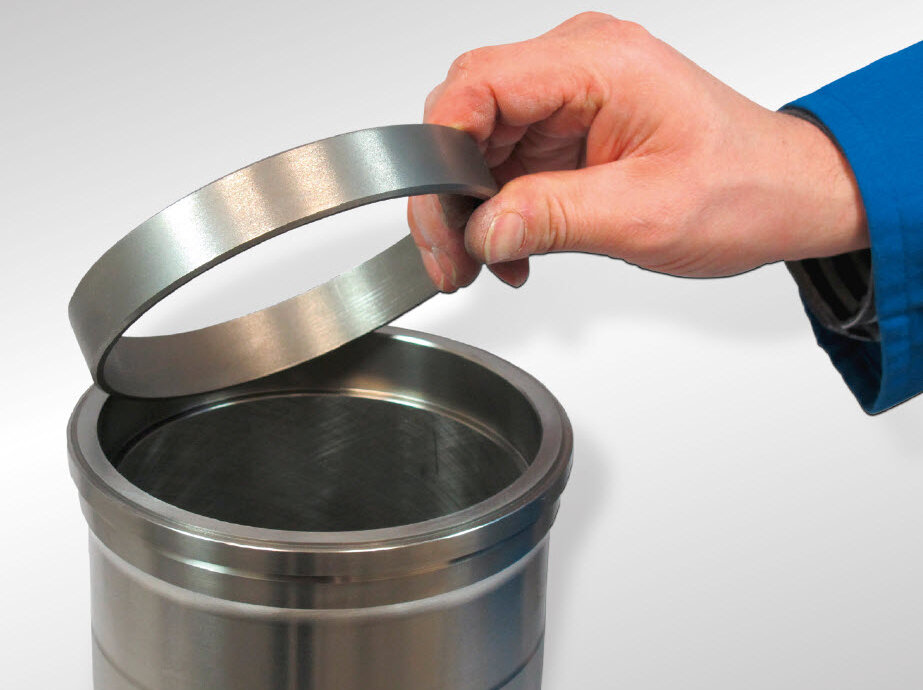
Cylinder liners with fire ring
Design, function and installation instructions
Cylinder liners with fire ring offer many advantages: A fire ring prevents a hard oil carbon deposit from forming on the top land. Find out what other advantages they offer, how a fire ring or oil scraper ring works and how the piston for cylinder liners with a fire ring is structured here.
SITUATION
To extend the durability of utility vehicle engines and cut harmful exhaust emissions, some engine manufacturers are increasingly using cylinder liners with a fire ring.
DESIGN AND FUNCTION
Fire rings are placed at the top end of the cylinder liners in a rectangular recess. The fire ring is inserted loosely in the designated recess during mounting. It is held in position later by the cylinder head.
A fire ring or oil scraper ring prevents a hard oil carbon deposit from forming on the top land of the piston. This is achieved by the smaller inside diameter of the fire ring compared to the diameter of the cylinder bore.
As the piston passes through top dead centre, the fire ring scrapes the unwanted oil carbon deposits off the piston and prevents deposits from forming on the top land.
PROBLEM AND SOLUTION
On cylinder liners with no fire ring, if the engine is used in unfavourable conditions a hard carbon layer can formon the top land of the piston (Fig. 4, left). Unfavourable operating conditions include:
- frequent short-distance drives
- frequent idle mode
- operation of the engine with unsatisfactory fuel and oil qualities
- lack of vehicle maintenance
REMOVING THE CYLINDER LINER
For the piston to be removed, the fire ring must first be removed from the cylinder liner. For used cylinder liners, this cannot immediately be done manually. Deposits between the fire ring and the cylinder liner cause the fire ring to be tightly stuck in its mounting. When removing defective cylinder liners, the fire ring can be destroyed using a chisel worked between the fire ring and the cylinder liner (Fig. 5).
If the cylinder liner and the fire ring are to be reused, the piston is moved slightly downwards by rotating the crankshaft, so that the fire ring is accessible. A used piston ring, with a diameter corresponding to that of the cylinder, is then inserted into the cylinder below the fire ring (Fig. 6).
Rotating the crankshaft causes the piston to move the fire ring out of the cylinder liner (Fig. 8). To prevent the piston ring used as a removal tool from becoming compressed and sliding over the fire ring, the joint gap must be bridged with a feeler gauge while sliding out the fire ring (Fig. 7).
If only the piston is to be removed, the cylinder liner must be fixed in place, i.e. pressed onto its seat. Otherwise, the piston will slide the fire ring and the cylinder liner out of the engine block.
INSTALLATION OF CYLINDER LINER
The cylinder liner is first inserted into the engine block without a fire ring. The piston and the connecting rod are then inserted into the cylinder and attached to the crankshaft as specified. When inserting the piston, it is essential to ensure that the piston ring clamp is pushed sufficiently far into the fire ring recess (Fig. 10). This makes sure that the piston rings do not rebound into the fire ring recess and suffer damage as a result. After installing the piston, the fire ring is placed in the recess manually. With used parts, a slightly stiff fire ring can be carefully knocked into the cylinder liner using a hammer and a block of wood (Fig. 9).
FITTING AND USAGE INSTRUCTIONS
- Pistons and cylinder liners with fire rings should be sold as a set to prevent incorrect combinations of parts and to avoid clearance problems.
- When only the piston is being replaced, it is important to ensure that it is designed for use with a fire ring (compare the diameter of the top land with the old part).
- When replacing only the cylinder liner, it is essential to ensure that the height of the fire ring is less than the height of the top land on the piston.
- The fire ring may not be left out. It must always be installed so that the engine will achieve its specified compression and performance.
- Fire rings are produced symmetrically, i.e. the ring has no specific direction of installation.
- When reworking the engine block sealing area, the specified piston protrusion dimension must be complied with or set and it must also be ensured that the first compression ring cannot collide with the fire ring.
- Fire rings are not honed on the inside diameter.
- Do not retrofit cylinder liners with fire rings if they are not approved by the manufacturer.
DELIVERY INFORMATION
Kolbenschmidt cylinder liners are always supplied as a complete kit, i.e. with fire ring and sealing rings. Fire rings are not available individually as spare parts.
Video - Installation of cylinder liners (EN) - Motorservice Group
We need your consent to load the YouTube service!
In order to play YouTube videos, a connection to YouTube must be established. This will also entail data processing and cookie usage by YouTube/Google (possibly also out of the USA). By clicking "Accept", you consent to this data processing and the placing of YouTube cookies on your terminal device. Your selection will be saved for future visits to this website. You may find further information under "More" and in our Data Protection Information.
Product groups
This might also interest you